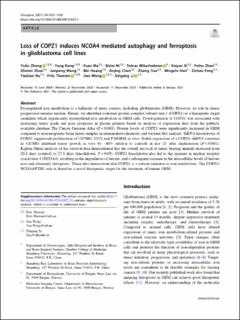Loss of COPZ1 induces NCOA4 mediated autophagy and ferroptosis in glioblastoma cell lines
Zhang, Yulin; Kong, Yang; Ma, Yuan; Ni, Shilei; Wikerholmen, Tobias Espedal; Xi, Kaiyan; Zhao, Feihu; Zhao, Zhimin; Wang, Junpeng; Huang, Bin; Chen, Anjing; Yao, Zhong; Han, Mingzhi; Feng, Zichao; Hu, Yaotian; Thorsen, Frits; Wang, Jiang; Li, Xingang
Journal article, Peer reviewed
Published version

View/
Date
2021Metadata
Show full item recordCollections
- Department of Biomedicine [710]
- Registrations from Cristin [9791]
Abstract
Dysregulated iron metabolism is a hallmark of many cancers, including glioblastoma (GBM). However, its role in tumor progression remains unclear. Herein, we identified coatomer protein complex subunit zeta 1 (COPZ1) as a therapeutic target candidate which significantly dysregulated iron metabolism in GBM cells. Overexpression of COPZ1 was associated with increasing tumor grade and poor prognosis in glioma patients based on analysis of expression data from the publicly available database The Cancer Genome Atlas (P < 0.001). Protein levels of COPZ1 were significantly increased in GBM compared to non-neoplastic brain tissue samples in immunohistochemistry and western blot analysis. SiRNA knockdown of COPZ1 suppressed proliferation of U87MG, U251 and P3#GBM in vitro. Stable expression of a COPZ1 shRNA construct in U87MG inhibited tumor growth in vivo by ~60% relative to controls at day 21 after implantation (P < 0.001). Kaplan–Meier analysis of the survival data demonstrated that the overall survival of tumor bearing animals increased from 20.8 days (control) to 27.8 days (knockdown, P < 0.05). COPZ1 knockdown also led to the increase in nuclear receptor coactivator 4 (NCOA4), resulting in the degradation of ferritin, and a subsequent increase in the intracellular levels of ferrous iron and ultimately ferroptosis. These data demonstrate that COPZ1 is a critical mediator in iron metabolism. The COPZ1/NCOA4/FTH1 axis is therefore a novel therapeutic target for the treatment of human GBM.
